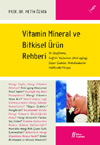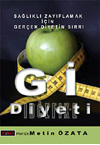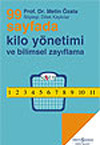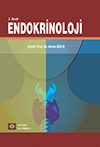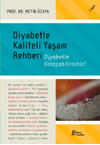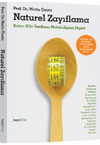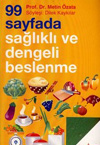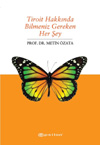|
YENİ ARAŞTIRMALAR
KAN TSH SEVİYESİNİ ALDIĞIMIZ İYOD MİKTARI, VUCUT KİTLEMİZ, MEVSİMLER VE YAŞ ETKİLER
Dan Med J. 2016 Jan;63(1). pii: B5196.
Determinants of TSH change in a community-based cohort.
Sigurd LB1.
Author information
Abstract
INTRODUCTION:
Thyroid disorders are common with occurrence primarily determined by the availability of dietary iodine. Iodine fortification programmes are internationally recommended to ensure sufficient iodine intake in populations. An understanding of the role of thyroid hormone levels within the normal range, set points and etiological factors related to thyroid disease development is important for optimal prevention and treatment. Limited data, however, exist regarding the impact of iodine fortification on thyroid function development. Additionally, the relation between body weight and thyrotropin (TSH) within the normal range and the role of female reproductive factors in the etiology of thyroid autoimmunity is debated.
OBJECTIVE:
The aim of this PhD project was to analyse the effect of a nationwide iodine fortification programme on individual development in thyroid function and to identify concurrent determinants for the possible changes. Furthermore, we aimed to investigate the association between weight and serum TSH change as well as the association between female reproductive factors and change in TSH and thyroid peroxidase antibody (TPO-Ab) status.
METHODS:
A longitudinal population-based study of the DanThyr C1 cohort examined before (1997-1998) and after (2008-2010) the introduction of mandatory iodine fortification of salt on July 1 2000. A total of 2,465 individuals participated in the follow-up examination. The main outcome measure was change in serum TSH. Change in TPO-Ab status was additionally used in Paper III.
RESULTS:
Urinary iodine excretion levels increased significantly during follow-up. Serum TSH also increased significantly, most pronounced in the region with the highest iodine intake, whereas the increase was not significant in the low-iodine-intake region. The presence of TPO-Ab at baseline and absence of goitre and multiple nodules were identified as determinants of TSH increase. Moreover, a low-normal TSH at baseline was a determinant of future decreased serum TSH, while likewise a high-normal baseline TSH values determined a TSH above normal reference range at follow-up. A positive association between 11-year serum TSH change and weight change was found, but without baseline body mass index being a determinant of future weight change and without baseline TSH being a determinant of future weight change. An inverse association between the time on HRT treatment and the risk of increased TPO-Ab status during follow-up was found, but the association was not significant when applying the Bonferroni adjusted significance level and not associated with TSH change. Parity, OCP use, abortions, age at menarche and menopausal status were associated neither with TSH change nor with increased TPO-Ab status during follow-up.
CONCLUSION:
TSH increased significantly, and the difference be-tween regions with different iodine intakes could indicate that iodine, at least partly, explains the TSH increase. The identified determinants of TSH change may indicate that susceptible individuals were subject to well-known adverse effects of iodine fortification. The predictive value of TSH on future TSH levels suggests a gradual development of thyroid disease. Whether body weight and TSH are causally connected remains to be proven. These results are an important contribution to the discussion of the role of thyroid hormones level within the normal range, set points and the association with body weight. A minor role, if any, is suggested for the studied female reproductive factors in development of thyroid autoimmunity. The longitudinal study neither solves the problem of causality nor is of the optimal design to measure the impact of iodization of salt, but can be informative in the study of determinants.
.................................................................
TİROİDİ AZ CALISAN HASTALARDA TABLET YERINE SIVI HALDEKI LT4 VERILINCE DAHA IYI SONUC ALINMIS/ ANCAK ULKEMIZDE YOK MAALESEF
Endocrine. 2015 Dec 31. [Epub ahead of print]
Oral L-thyroxine liquid versus tablet in patients with hypothyroidism without malabsorption: a prospective study.
Fallahi P1, Ferrari SM1, Antonelli A2.
Author information
Abstract
No consistent data are present in literature about the effectiveness of levothyroxine (L-T4) liquid formulation in patients without malabsorption. The aim of this study is to compare the effectiveness of L-T4 liquid formulation, with L-T4 tablets, in hypothyroid patients without malabsorption or drug interference. One hundred and fifty two patients were recruited. Patients were switched from the L-T4 therapy in tablets, to liquid L-T4 at the same dosage, 30 min before breakfast. Serum thyrotropic hormone (TSH), free thyroxine (FT4), and free triiodothyronine (FT3) were re-evaluated after 1-3 months (first control) and 5-7 months (second control) from the switch. TSH values significantly declined with respect to the basal value after the switch to liquid L-T4 both at the first control (P < 0.05) and at the second control (P < 0.01); FT4 and FT3 levels were not significantly changed. We show that liquid L-T4 is more effective than L-T4 tablet in controlling TSH levels in hypothyroid patients without malabsorption,
///////////////////////////////////////
Expert Opin Drug Deliv. 2014 Jul;11(7):1103-11. doi: 10.1517/17425247.2014.918101. Epub 2014 Jun 4.
The administration of L-thyroxine as soft gel capsule or liquid solution.
Vita R1, Fallahi P, Antonelli A, Benvenga S.
Author information
Abstract
INTRODUCTION:
Levothyroxine (l-T4) is the mainstay of treating hypothyroidism. The tablet is the traditional formulation of l-T4. Tablet l-T4 malabsorption results from either hindered gastric dissolution of the tablet or binding of l-T4 by sequestrants in the intestinal lumen.
AREAS COVERED:
This review provides an overview of the pharmacokinetics of l-T4 formulations available in the market: the tablet, the soft gel capsule and the oral solution. We review literature on the new formulations and anticipate the areas of future research.
EXPERT OPINION:
Failure of l-T4 treatment to reach target serum thyroid-stimulating hormone levels generally prompts the physicians to increase l-T4 daily dose. In vitro studies have shown that the soft gel capsule releases the active ingredient more consistently at varying pH than the tablet. In addition, in vivo studies have confirmed the in vitro data and have demonstrated that both the soft gel capsule and the liquid formulation are capable to solve tablet l-T4 malabsorption caused by certain drugs, bariatric surgery or coffee. These new formulations may be attractive also for patients who cannot/do not want to change their (improper) habits of l-T4 ingestion. Finally, the oral solution l-T4 could be suitable for patients who cannot swallow the solid formulations.
///////////////////////////////////////////////////////
EPILEPSI ILACI KULLANAN HASTALARDA TIROID HORMON OLCUMLERI ARALIKLARLA YAPILMALI
Eur J Endocrinol. 2015 Dec 23. pii: EJE-15-1081. [Epub ahead of print]
ASSOCIATION OF ANTIEPILEPTIC DRUG USAGE, TRACE ELEMENTS AND THYROID HORMONE STATUS.
Zevenbergen C1, Korevaar T2, Schuette A3, Peeters RP4, Medici M5, Visser TJ6, Schomburg L7, Visser E8.
Author information
Abstract
Background Levels of thyroid hormone (TH) and trace elements (copper (Cu), selenium (Se)) are important for development and function of the brain. Anti-epileptic drugs (AEDs) can influence serum TH and trace element levels. As the relationship between AEDs, THs and trace elements has not yet been studied directly, we explored these interactions. Methods 898 participants from the Thyroid Origin of Psychomotor Retardation (TOP-R) study, designed to investigate thyroid parameters in subjects with intellectual disability (ID), had data available on serum Se, Cu, TSH, FT4, T3, reverse T3, T4 and thyroxine binding globuline (TBG); 401 subjects were on AED treatment. Differences in trace elements according to medication usage was investigated using ANOVA, associations between trace elements and thyroid parameters were analysed using (non-)linear regression models. Results Study participants were not deficient in any of the trace elements analyzed. AED (carbamazepine, valproate, phenytoin) usage was negatively associated with serum Se and showed compound-specific associations with Cu levels. After correction for drug usage, Se was positively associated with TSH levels, negatively associated with FT4 levels and positively with T3 levels. Cu was positively associated with T4, T3 and rT3, which was largely dependent on TBG levels. Conclusions The subjects with ID did not display profound deficiencies in trace element levels. AEDs were associated with serum Se and Cu levels, while serum Se and Cu were also associated with thyroid parameters. Further studies on the underlying mechanisms and potential clinical importance are warranted. .
//////////////////////////////////////////////////////
TIROID NODULU OLAN HASTALARDA TSH YUKSEK ISE KANSER RISKI ARTIYOR
Endokrynol Pol. 2015;66(6):480-5. doi: 10.5603/EP.a2015.0059.
TSH levels are associated with increased risk of thyroid carcinoma in patients with nodular disease.
Fighera TM1, Perez CL, Faris N, Scarabotto PC, Silva TT, Cavalcanti TC, Mesa Junior CO, Miasaki F, Paz Filho GJ, Carvalho GA.
Author information
Abstract
INTRODUCTION:
Several studies have shown an increased risk of thyroid malignancies in patients with elevated TSH levels, even if these levels fell within the normal range. The aim of this study was to evaluate the relationship between TSH and risk of malignancy in patients with thyroid nodules.
MATERIAL AND METHODS:
We included 622 patients with thyroid nodules evaluated by fine needle aspiration and/or thyroidectomy and diagnosed by cytology or histology. Clinical and laboratory data, such as gender, weight, ultrasound findings, serum TSH, and free T4, were obtained from medical records or collected during each patient's first visit to our centre, prior to any intervention.
RESULTS:
Thyroid cancer was more prevalent in males (p = 0.012) and in patients with a solitary nodule (p < 0.01). Malignant tumours were predominantly solid, whereas benign tumours were solid or mixed (p = 0.053). The carcinoma risk in patients with thyroid nodules increased with increasing serum TSH concentration, with a significant elevation in patients with serum TSH levels above 1.64 mU/L (p < 0.001). This relationship persisted even when the subgroup of patients undergoing thyroidectomy was analysed separately. Patients with follicular lesions presented with significantly higher TSH levels compared to patients with benign cytology (p < 0.001). We also found correlation between elevated TSH and tumour size (p = 0.005).
CONCLUSIONS:
Our results suggest that in patients with nodular thyroid disease the carcinoma risk rose in parallel with serum TSH concentration, with significant increases evident in patients with serum TSH greater than 1.64 mU/L. (Endokrynol Pol 2015; 66 (6): 480-485).
|



